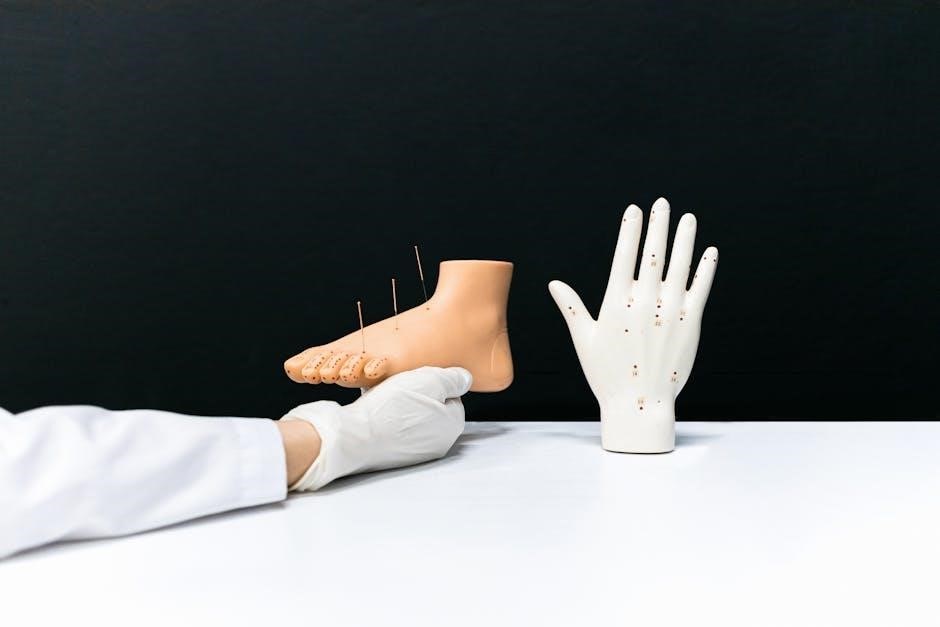The Guide to Physical Therapist Practice is a comprehensive resource developed by the American Physical Therapy Association (APTA) to outline the purpose, scope, and ethical standards of physical therapy practice, emphasizing evidence-based approaches and professional development.
1.1 Purpose and Scope of the Guide
The Guide to Physical Therapist Practice serves as a foundational document outlining the purpose and scope of physical therapy practice. Developed by the American Physical Therapy Association (APTA), it provides a framework for understanding the roles and responsibilities of physical therapists in the healthcare system. The guide emphasizes ethical standards, evidence-based approaches, and professional development, ensuring high-quality patient care. It is organized into volumes, with Volume I focusing on the role of physical therapists in healthcare and Volume II detailing patient management and interventions. The guide is now available as an online subscription, offering updated resources for practitioners.
1.2 Overview of the American Physical Therapy Association (APTA)
The American Physical Therapy Association (APTA) is the governing body for physical therapy in the United States, promoting best practices, ethical standards, and advancements in the profession. Established to support physical therapists and their assistants, the APTA aims to enhance patient care and public health through evidence-based approaches. It develops resources like the Guide to Physical Therapist Practice, which outlines professional standards and responsibilities. The APTA also advocates for the profession, ensuring physical therapy is recognized as a vital component of healthcare. By providing educational resources and updates, such as Guide 4.0, the APTA empowers practitioners to deliver high-quality, patient-centered care.
History and Evolution of the Guide
The Guide to Physical Therapist Practice was developed by the American Physical Therapy Association (APTA) to establish foundational standards for the profession. Initially published in print, it transitioned to digital formats like Guide 3.0 and Guide 4.0, enhancing accessibility and updating practices to reflect modern advancements in physical therapy.
2.1 Development of the Guide to Physical Therapist Practice
The Guide to Physical Therapist Practice was developed by the American Physical Therapy Association (APTA) to provide a foundational resource for the profession. It outlines the purpose, scope, and ethical standards of physical therapy, emphasizing evidence-based approaches and professional development. Initially published in print and CD formats, the guide has evolved to include digital versions, such as Guide 3.0 and Guide 4.0, enhancing accessibility and updating practices to reflect modern advancements. The guide serves as a seminal resource for physical therapists, detailing their roles in patient management, evaluations, and interventions, while also addressing the integration of technology and innovations in rehabilitation.
2.2 Key Updates in Recent Versions (3.0 and 4.0)
Recent versions of the Guide to Physical Therapist Practice, specifically 3.0 and 4.0, have introduced significant updates to reflect modern advancements in the field. Guide 3.0 emphasized evidence-based practices, ethical standards, and the integration of technology in rehabilitation. Guide 4.0 further expanded on these concepts, providing more detailed insights into patient management and emerging trends in physical therapy. Both versions transitioned from print and CD formats to online-only subscriptions, enhancing accessibility and ensuring practitioners have the most current information. These updates underscore the APTA’s commitment to advancing the profession and equipping physical therapists with the tools needed for optimal patient care.
Structure and Content of the Guide
The Guide to Physical Therapist Practice is organized into volumes, with Volume I focusing on the role of physical therapists in healthcare and Volume II detailing patient management and interventions.
3.1 Volume I: Role of Physical Therapists in the Healthcare System
Volume I of the Guide to Physical Therapist Practice focuses on the role of physical therapists within the healthcare system, detailing their responsibilities in patient evaluations, interventions, and overall management. It emphasizes their contribution to improving patient outcomes and integrating physical therapy into broader healthcare strategies. This section highlights the importance of physical therapists as key players in promoting mobility, function, and quality of life for patients across various settings. By outlining their roles, Volume I provides a foundational understanding of how physical therapists collaborate with other healthcare professionals to deliver comprehensive care.
3.2 Volume II: Patient Management and Interventions
Volume II of the Guide to Physical Therapist Practice delves into patient management and interventions, providing detailed strategies for effective care. It outlines evidence-based approaches for evaluating patients, developing treatment plans, and implementing interventions tailored to individual needs. This section emphasizes the importance of personalized care, focusing on improving mobility, strength, and functional abilities. It also explores various therapeutic techniques, including exercise, manual therapy, and education, to enhance patient outcomes. By offering practical tools and frameworks, Volume II equips physical therapists with the knowledge to deliver high-quality, patient-centered interventions across diverse clinical settings.

Core Concepts and Principles
The core concepts and principles of physical therapy practice emphasize evidence-based approaches, patient-centered care, and the integration of the International Classification of Functioning (ICF) framework.
4.1 Patient/Client Management Model
The Patient/Client Management Model is a framework that guides physical therapists in delivering care, emphasizing evaluation, diagnosis, prognosis, intervention, and outcomes. It ensures a structured approach to patient care, focusing on evidence-based practices and patient-centered goals. This model integrates assessment, treatment planning, and intervention strategies, promoting effective communication and collaboration between therapists and patients. By following this model, physical therapists can systematically address patient needs, ensuring personalized and efficient care. It also supports documentation and continuous improvement in practice, aligning with professional standards and ethical guidelines.
4.2 International Classification of Functioning (ICF)
The International Classification of Functioning (ICF) is a global framework that categorizes health and health-related domains. It emphasizes functioning, disability, and health, providing a standardized language for communication across healthcare disciplines. The ICF model considers body functions, body structures, activities, participation, and environmental factors, enabling a holistic approach to patient care. Physical therapists use the ICF to assess and address limitations in functioning, guiding interventions to enhance participation and quality of life. This framework aligns with patient-centered care and evidence-based practice, ensuring comprehensive and individualized treatment plans. The ICF is integral to the Guide, supporting goal setting and outcomes measurement in physical therapy practice.
Role of Physical Therapists in Healthcare
Physical therapists play a vital role in healthcare by evaluating, diagnosing, and managing movement disorders, improving mobility, and enhancing quality of life through evidence-based interventions and patient education.

5.1 Responsibilities in Patient Evaluation and Assessment
Physical therapists are responsible for conducting thorough patient evaluations and assessments to identify movement-related disorders and functional limitations. This includes performing initial examinations, diagnosing conditions, and establishing prognoses. They use standardized assessment tools to measure strength, range of motion, balance, and mobility. Effective communication with patients and other healthcare providers is essential to understand medical history, symptoms, and treatment goals. Based on these evaluations, physical therapists develop personalized care plans tailored to address specific needs and promote optimal outcomes. Accurate documentation of findings ensures continuity of care and informs evidence-based interventions.
5.2 Responsibilities in Patient Interventions and Care
Physical therapists are responsible for designing and implementing evidence-based interventions tailored to individual patient needs. This includes creating personalized treatment plans, utilizing therapeutic exercises, manual therapy, and modalities to enhance mobility and function. They educate patients on proper techniques, self-care strategies, and injury prevention. Physical therapists also monitor progress, adjust interventions as needed, and ensure patient safety throughout the care process. Effective communication with patients and other healthcare providers is crucial to coordinate care and achieve optimal outcomes. Documentation of treatment sessions and patient responses is essential for continuity of care and to inform future interventions.

Ethical and Legal Considerations
The guide outlines ethical standards, emphasizing patient autonomy, confidentiality, and informed consent. It also addresses legal frameworks, ensuring compliance with regulations and professional accountability in practice.
6.1 Ethical Standards in Physical Therapy Practice
The Guide to Physical Therapist Practice emphasizes ethical standards, including patient autonomy, confidentiality, and informed consent. It highlights the importance of professionalism, integrity, and respect for diversity. These principles ensure that physical therapists prioritize patient well-being, maintain trust, and adhere to moral obligations. The guide also addresses the responsibility of physical therapists to uphold ethical conduct in all interactions, whether with patients, colleagues, or the healthcare system. By adhering to these standards, physical therapists contribute to a high-quality, patient-centered care environment that respects individual rights and promotes ethical decision-making in practice.
6.2 Legal Framework Governing Physical Therapy
The legal framework governing physical therapy practice ensures adherence to state and federal regulations, including licensure requirements and scope of practice definitions. The APTA Guide to Physical Therapist Practice provides clarity on legal standards, emphasizing compliance with laws related to patient care, confidentiality, and documentation. It also addresses liability concerns and the importance of staying informed about evolving legal requirements. By understanding and adhering to these legal guidelines, physical therapists maintain professional accountability and ensure safe, lawful practice. The guide serves as a resource for navigating the complex regulatory landscape, supporting practitioners in delivering care within established legal boundaries.

Evidence-Based Practice
Evidence-based practice integrates research, clinical expertise, and patient values to guide physical therapy decisions, ensuring effective and personalized care, enhancing outcomes, and promoting best practices in rehabilitation.
7.1 Importance of Research in Physical Therapy
Research is essential for advancing physical therapy, ensuring evidence-based practices, and improving patient outcomes. It drives the development of new interventions, technologies, and methodologies, keeping the profession aligned with current scientific advancements. By investigating the effectiveness of treatments, research informs clinical decision-making and enhances the quality of care. The American Physical Therapy Association (APTA) emphasizes the role of research in shaping best practices and ethical standards. Continuous investment in research ensures that physical therapists deliver safe, effective, and patient-centered care, addressing diverse needs and promoting optimal functional outcomes across various populations and conditions.
7.2 Clinical Decision-Making and Evidence-Based Approaches
Clinical decision-making in physical therapy relies on evidence-based approaches to ensure effective and safe patient care. The Guide to Physical Therapist Practice emphasizes the integration of research findings, patient values, and clinical expertise to inform treatment plans. Evidence-based practice (EBP) is crucial for selecting interventions that improve outcomes and minimize risks. By adhering to EBP, physical therapists can address diverse patient needs, promote functional recovery, and maintain high standards of care. The guide provides frameworks and tools to support therapists in applying evidence-based principles, ensuring that decisions are grounded in the best available research and tailored to individual patient circumstances.
Functional Training and Patient Education
Functional training focuses on self-care and daily activities, enabling patients to perform tasks efficiently. Patient education empowers individuals to improve functional abilities and reintegrate into daily routines.
8.1 Self-Care and Domestic Life Integration
Self-care and domestic life integration are critical components of functional training, focusing on improving patients’ ability to perform daily tasks and maintain independence. Physical therapists design personalized programs to enhance efficiency in self-care activities, such as bathing, dressing, and household management. These interventions aim to adapt tasks to the individual’s capabilities, ensuring safety and reducing strain. The integration of domestic life skills is tailored to the patient’s living environment, incorporating adaptive equipment and home exercises. This approach not only restores functional abilities but also boosts confidence and overall quality of life, enabling individuals to reintegrate seamlessly into their daily routines and responsibilities.
8.2 Reintegration into Daily Activities
Reintegration into daily activities is a cornerstone of physical therapy, focusing on helping patients resume their normal routines and community participation. Physical therapists use functional training to address mobility, strength, and balance, enabling patients to perform tasks like work-related activities, hobbies, and social engagements. The process involves assessing the patient’s current abilities and creating tailored programs to bridge gaps in functionality. Adaptive strategies and equipment are often incorporated to facilitate smoother transitions. The goal is to enhance independence, reduce limitations, and improve overall quality of life, ensuring patients can fully engage in activities that are meaningful to them and their communities.

Technology and Innovations in Physical Therapy
Technology and innovations are transforming physical therapy, enhancing patient care through telehealth, wearable devices, and AI-driven tools, as outlined in the APTA Guide to Physical Therapist Practice.
9.1 Use of Digital Tools in Practice
Digital tools are revolutionizing physical therapy practice, enhancing efficiency and patient outcomes. Telehealth platforms enable remote consultations, expanding access to care. Wearable devices and mobile apps monitor patient progress, fostering adherence to treatment plans. Electronic health records (EHRs) streamline documentation, improving data accuracy and communication. The APTA Guide to Physical Therapist Practice 4.0 emphasizes the integration of these technologies to support evidence-based care. Digital tools also facilitate personalized interventions, real-time feedback, and better tracking of functional improvements. By leveraging these innovations, physical therapists can deliver more effective and patient-centered care, aligning with the guide’s focus on modern, efficient practice standards.
9.2 Emerging Trends in Rehabilitation Technology
Emerging trends in rehabilitation technology are transforming physical therapy practice, offering innovative solutions for patient care. Advances in artificial intelligence (AI) and robotics enable personalized treatment plans and real-time feedback. Virtual reality (VR) creates immersive environments for rehabilitation, enhancing engagement and outcomes. Wearable sensors and devices track patient progress remotely, improving adherence to therapy regimens. Telehealth platforms expand access to care, especially for underserved populations. These technologies, highlighted in the APTA Guide to Physical Therapist Practice 4.0, emphasize the integration of cutting-edge tools to enhance efficiency, precision, and patient-centered care. They pave the way for a future where technology-driven rehabilitation is both accessible and effective.
Specialized Areas of Practice
The Guide to Physical Therapist Practice highlights specialized areas such as neurology, geriatric, orthopedic, and sports physical therapy, detailing their unique roles in patient care and rehabilitation.
10.1 Neurology and Geriatric Physical Therapy
Neurology and geriatric physical therapy focuses on addressing impairments in individuals with neurological disorders, such as stroke, brain injuries, or Parkinson’s disease, and older adults with age-related conditions. Techniques include motor retraining, balance exercises, and adaptive strategies to enhance mobility and independence. Geriatric physical therapy emphasizes functional training to improve daily activities, manage chronic conditions like arthritis, and prevent falls. Both areas prioritize patient-centered care, incorporating evidence-based interventions to optimize quality of life and promote participation in meaningful activities. These specialized practices highlight the importance of tailored approaches to address unique challenges in neurologic and aging populations.
10.2 Orthopedics and Sports Physical Therapy
Orthopedics and sports physical therapy focuses on treating musculoskeletal injuries, post-surgical rehabilitation, and enhancing athletic performance. Physical therapists address conditions like fractures, sprains, and chronic pain, using exercises, manual therapy, and bracing. Sports therapy emphasizes injury prevention, functional training, and return-to-play strategies for athletes. Techniques include strength training, flexibility exercises, and biomechanical analysis to improve movement efficiency. The goal is to restore mobility, reduce pain, and optimize physical function, enabling patients to resume daily activities or competitive sports safely and effectively. This specialized practice integrates evidence-based approaches to address the unique needs of orthopedic and athletic populations.

Continuing Education and Professional Development
Continuing education is essential for physical therapists to stay updated on best practices, research, and advancements. The guide emphasizes lifelong learning and provides resources for professional growth.
11.1 Importance of Lifelong Learning in PT
Lifelong learning is essential for physical therapists to stay current with advancements in research, technologies, and clinical practices. The guide underscores the need for continuous professional development to ensure evidence-based care and adaptability to evolving patient needs. By engaging in ongoing education, physical therapists enhance their skills, improve patient outcomes, and maintain professional competency. The guide provides resources and frameworks to support this commitment, fostering a culture of continuous improvement and excellence in practice.
11.2 Resources for Professional Growth
The Guide to Physical Therapist Practice highlights various resources to support professional growth, including continuing education courses, webinars, and specialized certifications. The APTA offers online platforms, such as its Learning Center, which provides access to evidence-based content and clinical practice guidelines. Additionally, professional networks and mentorship programs encourage collaboration and skill development. These resources enable physical therapists to stay updated on industry advancements, refine their expertise, and adapt to emerging trends in patient care. By leveraging these tools, professionals can enhance their competencies and contribute to the evolution of physical therapy practice.

The Guide’s Impact on Physical Therapy Education
The Guide to Physical Therapist Practice significantly influences physical therapy education by standardizing curricula and clinical training, ensuring students align with best practices and evidence-based care.
12.1 Integration into Academic Curricula
The Guide to Physical Therapist Practice is widely integrated into academic curricula, serving as a foundational resource for physical therapy education. It provides a standardized framework for teaching core concepts, such as patient management, ethical standards, and evidence-based practice. By incorporating the guide, educational programs ensure students align with current best practices and professional expectations. The guide’s structured content supports curriculum development, enabling faculty to emphasize key areas like clinical decision-making and functional training. This integration prepares students to meet the demands of modern healthcare, fostering competent and ethical physical therapy professionals. Its inclusion enhances the quality of physical therapy education nationwide.
12.2 Role in Clinical Training and Residency Programs
The Guide to Physical Therapist Practice plays a pivotal role in clinical training and residency programs by providing a standardized framework for hands-on learning. It bridges theoretical knowledge with practical application, ensuring trainees develop competencies aligned with professional standards. The guide is often used in residency programs to enhance clinical decision-making, patient evaluation, and intervention skills. Its structured content supports mentorship and feedback processes, fostering professional growth. By integrating the guide, programs ensure residents are well-prepared to address complex patient needs effectively. This resource is instrumental in shaping skilled, evidence-based practitioners who meet the evolving demands of healthcare.

Accessing the Guide
The Guide to Physical Therapist Practice is accessible as an online subscription, offering convenient access to regularly updated resources and evidence-based practices for physical therapists.
13.1 Availability as an Online Subscription
The Guide to Physical Therapist Practice is now exclusively available through an online subscription, replacing its previous book and CD formats. This digital access ensures convenient and instant availability, allowing physical therapists to stay updated with the latest evidence-based practices and professional standards. The online format enables easy searches, regular updates, and access to multimedia resources, enhancing usability. Subscribers can access the guide from any device, making it a flexible resource for both clinical and educational settings. This shift to a digital platform aligns with modern healthcare trends, promoting efficiency and continuous learning for physical therapy professionals worldwide.
13.2 Benefits of the Digital Format
The digital format of the Guide to Physical Therapist Practice offers numerous benefits, including enhanced accessibility and convenience. Users can access the guide from any device with internet connectivity, making it ideal for clinicians on the go. The digital version allows for efficient searching, bookmarking, and note-taking, improving workflow. Regular updates ensure that subscribers have the most current information without needing physical storage space. Additionally, the digital format reduces environmental impact and provides cost-effective access to essential resources. These features collectively enhance the usability and value of the guide for physical therapy professionals, supporting lifelong learning and evidence-based practice.

Conclusion
The Guide to Physical Therapist Practice remains a cornerstone for professionals, offering insights into best practices, ethical standards, and evidence-based care, shaping the future of physical therapy.
14.1 Summary of Key Takeaways
The Guide to Physical Therapist Practice is a foundational resource by the American Physical Therapy Association (APTA), outlining the purpose, scope, and ethical standards of physical therapy. It emphasizes evidence-based practices, patient-centered care, and professional development. The guide has evolved to include digital formats, such as Guide 4.0, enhancing accessibility for practitioners. It serves as a critical tool for education and clinical practice, providing a framework for patient evaluation, interventions, and outcomes. By integrating the latest research and technologies, the guide ensures physical therapists deliver high-quality, contemporary care, addressing the diverse needs of patients across various settings.
14.2 Future Directions for the Guide and Physical Therapy Practice
The Guide to Physical Therapist Practice is expected to continue evolving, incorporating advancements in technology and evidence-based practices. Future updates may focus on integrating artificial intelligence, telehealth, and wearable technology to enhance patient care. The guide will likely expand its emphasis on personalized treatment plans and interdisciplinary collaboration. Additionally, there may be a greater focus on global health initiatives, ensuring the guide addresses diverse healthcare systems worldwide. By staying at the forefront of innovation, the guide will remain a vital resource for physical therapists, supporting their role in delivering high-quality, patient-centered care in an ever-changing healthcare landscape.

